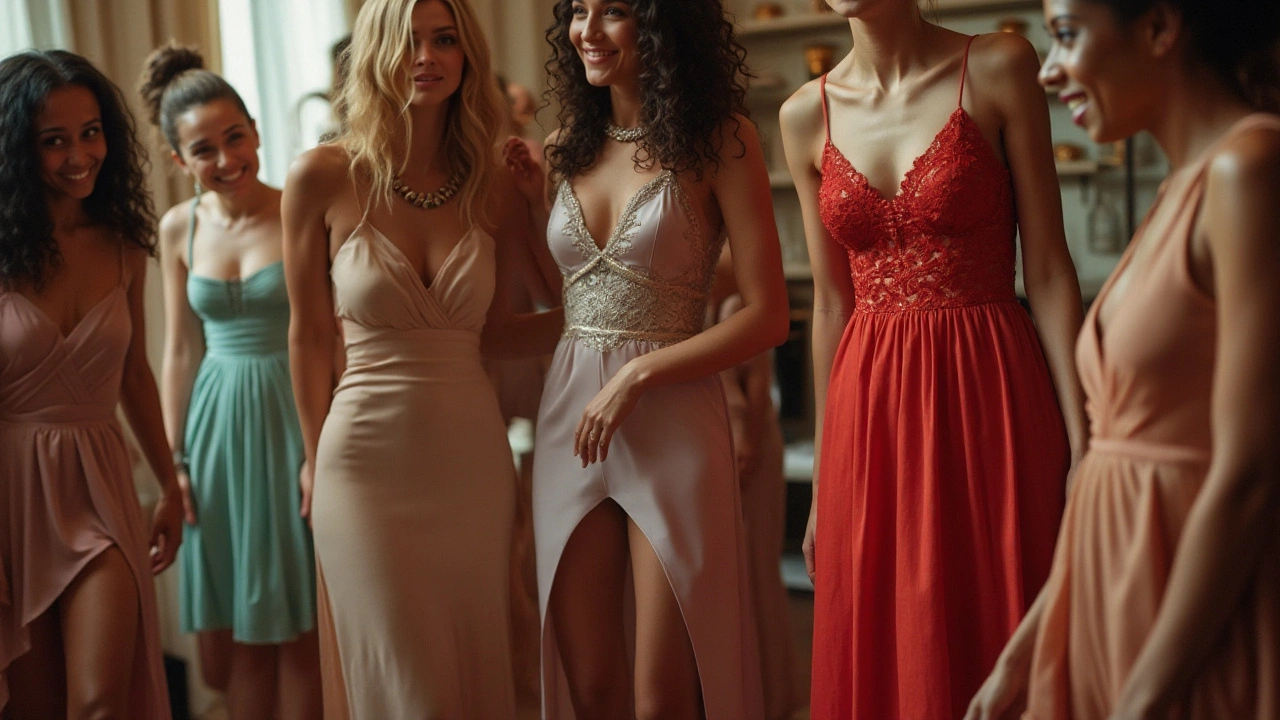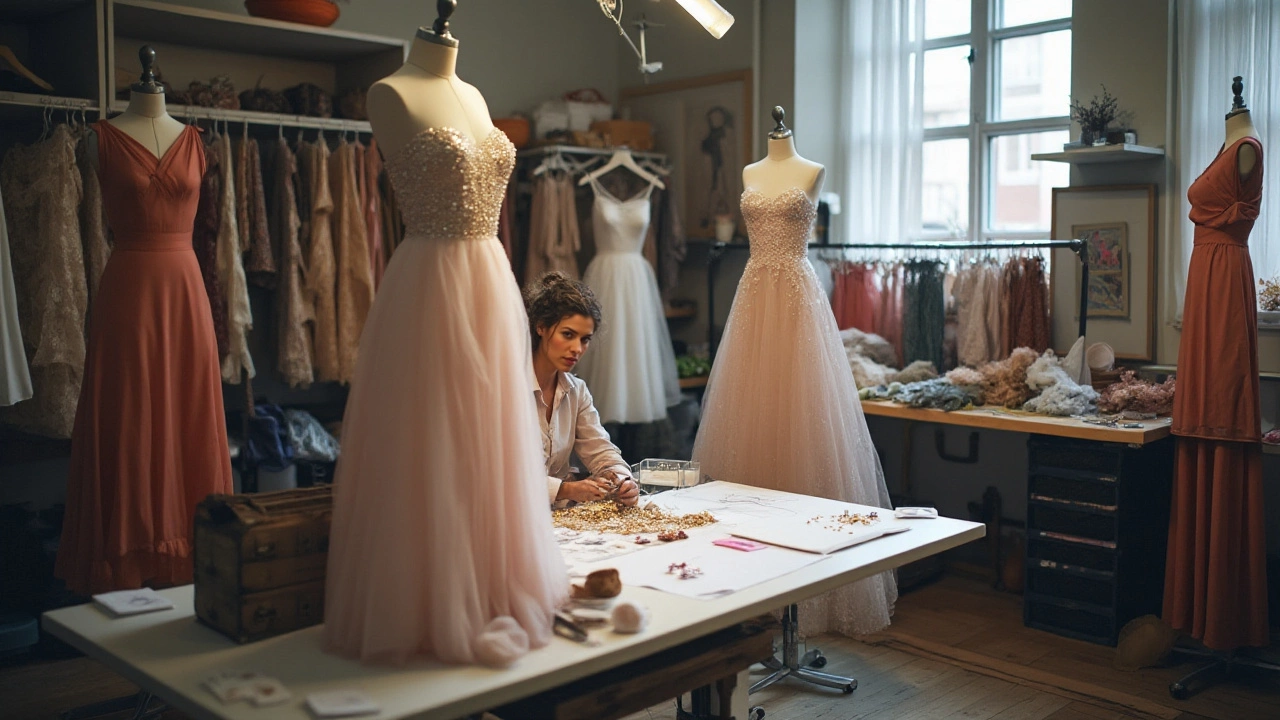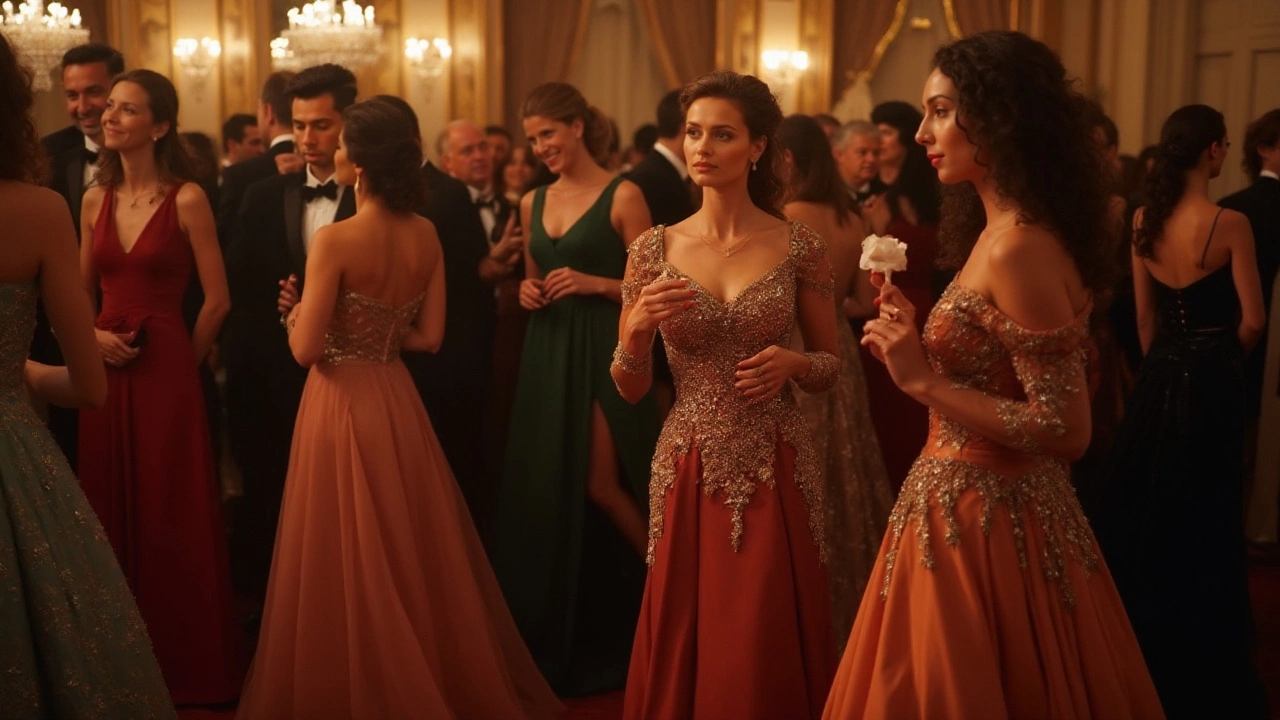The world of fashion offers a dazzling array of options for expressing one's style, and two staples in this world are dresses and evening gowns. While these terms might seem interchangeable to the untrained eye, they serve unique roles in a wardrobe and are best suited for different scenarios. Understanding the subtle nuances between a dress and an evening gown can elevate your fashion choices and help you shine at any event.
A dress is a versatile garment that can range from casual attire to something more formal. It can be short or long, simple or elaborate, and fits into any part of a woman's wardrobe. In contrast, evening gowns are the epitome of elegance, crafted specifically for high-profile occasions. They are known for their sophisticated designs, often floor-length, featuring fine fabrics like silk or chiffon.
Choosing the right one depends on the occasion, personal style, and sometimes even the season. Whether you're attending a cocktail party or an exclusive gala, knowing these differences will ensure you pick the perfect outfit that not only suits the event but also accentuates your personal flair.
- Defining a Dress
- Characteristics of an Evening Gown
- Occasions to Wear a Dress
- When to Choose an Evening Gown
- Style Tips for Evening Attire
- Interesting Facts About Evening Wear
Defining a Dress
A dress is a garment that holds a remarkable role in fashion, renowned for its versatility across numerous occasions. Unlike the more formal evening gown, dresses can seamlessly transition from casual daywear to a sophisticated evening look with the change of accessories or fabric choice. Typically, a dress includes a bodice and a skirt, forming a single piece that simplifies styling while offering a canvas for endless creativity.
The history of the dress is as extensive as it is varied, dating back to ancient civilizations where garments were draped across the body. Over time, these evolved into structured shapes that reflected societal changes, fashion trends, and technological advancements in textile production. In the twentieth century, fashion icons such as Coco Chanel revolutionized the dress by advocating for comfort and elegance in women's clothing, bringing about iconic designs like the little black dress.
Dresses can embody a wide range of styles, characterized by their silhouettes, necklines, lengths, and fabrics. Popular silhouettes include the A-line, which gently flares out from the waist, and the sheath dress, which clings to the body's contours. Necklines vary from classic options like round and V-neck to daring plunges or off-shoulder designs, allowing for expression of personal style. The length can range dramatically from the mini skirt to ankle-length maxis, offering a dress for every preference and occasion.
In contemporary fashion, dresses are designed to cater to both function and aesthetics. The smart casual dress has emerged as a staple, allowing one to easily dress up or down depending on the necessary dress code. Consider fabrics: cotton and jersey for casual wear, wool for colder months, and silk for a touch of luxury. Versatility extends to prints and patterns too, ranging from timeless florals and stripes to bold abstract designs, keeping wardrobes vibrant and diverse.
Today's fashion scene celebrates diversity of design and fit, encouraging individuals to choose dresses that accentuate their best features and provide comfort. It's interesting to note that nearly 50% of women wear a dress at least once a month, highlighting its significance in our daily lives. A survey conducted two years ago indicates that 70% of working women prefer dresses for work as they find them easier than coordinating separates.
Characteristics of an Evening Gown
An evening gown is often perceived as the queen of a woman's wardrobe, exuding elegance and sophistication. Unlike a regular dress, evening gowns are typically reserved for the most formal of occasions. They are known for their luxurious materials such as silk, velvet, chiffon, or satin, which not only drape beautifully but also make a striking visual statement. The length of an evening gown is traditionally floor-length, signaling opulence and formality, which sets it apart from other forms of formal attire. However, in contemporary fashion, shorter evening gowns have started to gain popularity, primarily for their maneuverability and fresh style.
The design of an evening gown can vary greatly, from classic silhouettes like the A-line or mermaid cut to more avant-garde styles that push the boundaries of traditional fashion. The construction of an evening gown is precision-oriented, often adorned with embellishments such as sequins, embroidery, lace, or beads, turning the garment into a work of art. Necklines vary from high and modest to plunging and daring, each offering a distinct flair. The sleeves, if present, range from full-length to cap or even completely absent, depending on current trends and personal preference.
One of the unique elements that distinguish an evening gown is its palette. Darker, more subdued shades like black, navy, or burgundy are common, though jewel tones and metallics have found their place in this category as well. These colors not only enhance the gown's inherent elegance but also complement evening settings under ambient lighting. An often-overlooked feature is the gown's lining, which plays a crucial role. It ensures the gown maintains its silhouette and fits the wearer seamlessly, enhancing the comfort as well as the grace with which it hangs.
As Vera Wang, a renowned designer, once said, "An evening gown is synonymous with a much larger design understanding. It’s couture."
Accessories are equally significant when it comes to styling an evening gown. Pairing the gown with the right jewelry, shoes, and clutch can elevate even the simplest designs to breathtaking heights. The importance of proper undergarments can't be overstated, as they provide the necessary foundation for the gown to look its best. Attention should be paid to the gown's hemline to ensure it doesn’t trail unnecessarily, which could detract from the overall effect. Given their elaborate nature and rich materials, the care instructions for evening gowns are specific. Most require delicate handling, usually suggesting dry cleaning to maintain their lustrous appeal and intricate details.

Occasions to Wear a Dress
When it comes to choosing the appropriate attire for various events, a dress often becomes the go-to choice for many women. Its versatility is unmatched, allowing it to fit both casual and formal settings with ease. A classic day in your favorite dress might begin in the office, unfold over lunch with friends, and conclude at a trendy evening gathering. With a simple change of accessories or shoes, a dress can easily transform along with the day's changing agenda.
The workplace is one common occasion where dresses shine, particularly during business meetings and corporate events. Many professionals lean towards dresses that balance style with elegance, like a sheath or shift dress. These styles are often knee-length and designed in subtle colors or patterns, ensuring a professional appearance. Pairing them with a smart blazer can add a layer of authority, signaling readiness and confidence. When the clock strikes evening, shedding the blazer and adding statement jewelry can effortlessly transition the outfit to an after-work dinner setting.
Casual outings offer yet another perfect occasion for wearing a dress. For brunch with friends or a shopping spree, a sundress is often a delightful choice. Loose-fitting and usually adorned with flowers or fun prints, sundresses embody the whimsical spirit of leisure. Their breathable fabric ensures comfort on a warm day while still keeping one stylishly clad. Introducing a denim jacket and a pair of comfy sneakers can complete the ensemble for that perfect casual-day look.
Special family gatherings, be it birthdays or anniversaries, often prompt a more dressed-up appearance without being overly formal. On such occasions, an A-line or wrap dress can add just the right amount of polished flair. These styles suit many body types, allowing wearers to radiate confidence and charm. A touch of personalized detail through accessories, like a beloved necklace or bracelet, can make the outfit meaningful and memorable.
Outdoor events, especially in summer, serve as a wonderful backdrop for experimenting with dress styles. Bohemian-inspired maxi dresses make a popular choice for music festivals or beach parties. Their flowing nature and vibrant hues can infuse grace and vibrancy into any gathering against the picturesque landscape. Complementing such dresses with feathered earrings or a woven tote bag can accentuate that laid-back yet chic appeal.
The renowned designer Diane von Furstenberg once said, "Feel like a woman, wear a dress!" This quote echoes the sentiment that a dress, in any style or fit, empowers women to express their personal style and confidence.
Weddings, although primarily the domain of the evening gown, often allow guests a wider range of dress choices. Summer weddings may encourage lighter dresses in pastel shades, while an autumn ceremony might inspire deeper tones like burgundy or emerald. Midi dresses fit comfortably within many wedding dress codes, maintaining elegance without overshadowing the main attraction. Accompanied by tasteful accessories, such a dress can fulfill the perfect guest appearance.
When to Choose an Evening Gown
Ah, the elegance and mystery of an evening gown! It's a unique garment that holds the power to captivate and enchant. An evening gown is more than just a piece of clothing; it's a statement, a celebration of style and grace. But when exactly should you opt for such a formal piece? The answer lies not only in the type of occasion but also in the impact you wish to make. Evening gowns are quintessential at events that celebrate luxury and sophistication. Galas, charity balls, and formal award ceremonies are prime examples where the red carpet might stretch out, inviting exclusivity and flair. In these settings, the evening gown doesn't just belong—it reigns supreme.
It's essential to consider the ambiance and expected dress code of the occasion. Luxury yachts, black-tie weddings, and opulent New Year's Eve parties often demand that same level of grandeur and elegance that only an evening gown can provide. The gown's rich fabrics and exquisite tailoring align seamlessly with the desires to leave a lasting impression. In these moments, the gown becomes an extension of one's prestige, echoing the event's formality and refined elegance. Renowned fashion icon Coco Chanel once remarked,
"Dress shabbily and they remember the dress; dress impeccably and they remember the woman."This highlights the magic an evening gown can cast on such moments.
The time of day can also influence the decision to wear an evening gown. Usually, events that unfold under the tranquil embrace of the night sky or in dimly lit venues call for something breathtakingly formal. Festivals that celebrate art or music under the stars would also see evening gowns shimmering in the moonlight. Opting for a gown during these occasions means you've chosen dignity over simplicity and allure over the mundane. Consider choosing colors that complement the theme or setting—rich jewel tones or metallics often shine at formal events held in elegant halls, while more subdued shades might suit garden or beachside soirées. Gowns with embellished details or unique cuts add a touch of drama befitting the grandeur that the night demands.
Interest in evening gowns has seen a rise in recent years, especially among millennials who appreciate the vintage charm and statement they make. Let's illustrate this trend with data:
| Year | Evening Gown Sales (in million units) |
|---|---|
| 2021 | 3.5 |
| 2022 | 4.0 |
| 2023 | 4.7 |

Style Tips for Evening Attire
Choosing the perfect outfit for a glamorous evening event means striking a balance between classic elegance and modern trends. It often starts with understanding the occasion and embracing fashion's wonderful versatility. It's about feeling comfortable and confident. Begin by considering your evening gown's silhouette. Whether you're opting for a classic A-line, a figure-hugging mermaid, or a timeless ball gown, each shape can create a distinct impression. The A-line flatters nearly every body type, while mermaid gowns accentuate curves, creating an ultra-glamorous look. Ball gowns evoke fairy-tale elegance and are perfect for black-tie events.
Colour selection is another key aspect. Rich, deep hues such as emerald, burgundy, and navy complement most skin tones and offer a sophisticated air. However, don't shy away from bold colors if it aligns with your personal style and the event theme. Fabrics also play a crucial role; luxurious materials like silk, chiffon, and satin not only look stunning under evening lights but also add an air of luxury that can transform your presence.
Accessorizing is the icing on the cake. A simple clutch can elevate your look, especially when matched with your gown's tone. Jewels can add sparkle; however, remember less is often more. Choose between statement earrings or a necklace, not both, to avoid overwhelming your gown. Heels can elongate the silhouette, but comfort should not be sacrificed. An elegant pair of flats is increasingly becoming an accepted and popular option, especially when the event involves long periods of standing or dancing.
Hair and makeup will also add to your final look. A sleek updo can complement an open-back gown, while loose curls might beautifully frame the face and highlight its natural features. Match the makeup with the colors of the gown: a bold lip for a simple dress or a shimmery eye for added drama. “Fashion is the armor to survive the reality of everyday life,” as designer Bill Cunningham said, and the right styling tips ensure you're armored for the perfect evening.
Styles evolve, and fashion is ever-changing, so stay informed about current trends while sticking true to your style. Mix and match older pieces with new favorites for a sustainable approach, and don't forget about the power of tailoring to make any gown uniquely yours. Attention to detail and a touch of personality will ensure your evening attire stands out, leaving a lasting impression at any event.
Interesting Facts About Evening Wear
The world of evening wear is steeped in rich history and elegance, reflecting cultural shifts and the evolving role of fashion in society. One intriguing fact about evening gowns is their origin in the French court of the 15th century, where extravagance was not just admired but expected. Couture designers competed fiercely to outdo each other, using lavish fabrics and intricate designs to capture the queen’s interest. This opulence is a tradition that many modern designers continue today, infusing each evening gown with a sense of grandeur that harkens back to those early days.
Evening gowns have long been synonymous with Hollywood, immortalized by silver screen legends like Audrey Hepburn and Grace Kelly. Perhaps the most iconic example is the black dress worn by Hepburn in “Breakfast at Tiffany’s,” designed by Hubert de Givenchy. The dress became an instant classic, representing sophistication and timeless style. Such cultural moments underscore the power of fashion in storytelling and set a high bar for style that many aspire to emulate. In the words of the legendary Coco Chanel:
“Dress shabbily and they remember the dress; dress impeccably and they remember the woman.”
The impact of evening wear extends beyond aesthetics; it's a statement of empowerment. During the 20th century, as women fought for their rights, fashion echoed this pivotal journey. Evening attire, which traditionally symbolized femininity, was increasingly used to express individuality and strength. Designers began exploring bold cuts and innovative materials, giving rise to evening gowns that were as much about comfort and confidence as they were about beauty. This shift helped redefine the perception of a dress, breaking away from restrictive designs to more liberating and expressive silhouettes.
Today, evening wear continues to evolve, with sustainable fashion making its mark. Many designers are now incorporating eco-friendly materials, acknowledging the fashion industry’s role in environmental sustainability. From recycled fabrics to less water-intensive dyes, the focus is on reducing the carbon footprint without compromising on style and elegance. This movement towards sustainability signifies a conscious shift in how high fashion balances luxury with responsibility.
The diversity in evening wear also mirrors changing societal norms, embracing a myriad of body types, styles, and cultural influences. Designers draw inspiration from global traditions, crafting garments that celebrate diversity on the international stage. Evening gowns are no longer confined to traditional shapes and colors; today’s designs are as varied as the people who wear them, reflecting a kaleidoscope of heritage and personal expression.
As fashion continues to break boundaries, technology becomes a key player. The integration of smart textiles, such as those that change color or fit based on body temperature, is paving a new frontier for evening wear. Imagine wearing a dress that can transform throughout an event! This innovation points to an exciting future where fashion adapts dynamically to the wearer’s needs and desires, merging style with functionality in profound ways.

